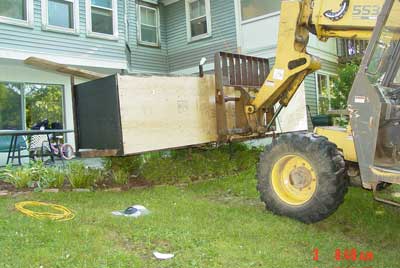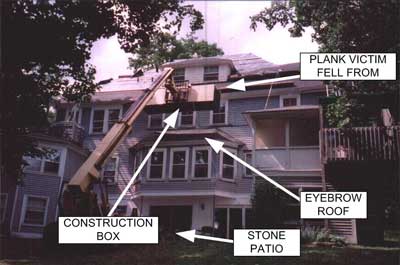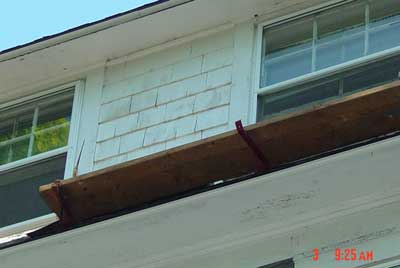Seventeen Year Old Female Laborer Falls From Residential Roof and Dies Nine Days Later – Connecticut
NIOSH In-house FACE Report 2007-10
July 30,2009
Summary
On July 2, 2007, a 17-year-old female laborer (the victim) fell approximately 26 feet from a residential roof to a stone patio; she died nine days later from her injuries. The victim was working for a construction company replacing a residential roof. The victim unloaded bales of roofing shingles from a construction box that was raised and attached to a forklift. The victim unloaded the bales and placed them on a wooden plank above her on the roof. The victim then sat on the plank and handed the bales to one of the owners of the company and a male laborer. While working on the roof, one of the owners and the male laborer heard a “thud” and looked over at the plank, but did not see the victim. They moved to the edge of the roof and looked down and saw the victim lying face down on a stone patio. The owner and the male laborer climbed down from the roof. While climbing down the owner yelled to the other owner in the yard area to go check on the victim. When the owner got down from the roof he called 911 for help, as the other owner checked the victim. During this time, the victim was lying unconscious and her head was bleeding profusely.
Emergency Medical Services (EMS) and the state police were dispatched to the incident, and the victim was transported via ambulance to an area hospital. At the hospital the victim was stabilized, then airlifted to another hospital where she remained unconscious in critical condition. She died from her injuries nine days later. Key contributing factors identified in this investigation include failure to recognize and control the fall hazard and assignment of a young worker to a prohibited hazardous task.
NIOSH investigators concluded that, to help prevent similar occurrences, employers should:
- know and comply with child labor laws which include prohibitions against work by youths less than 18 years of age in occupations that involve roofing
- ensure that workers are protected against falling while working at an elevation and that fall protection is provided when the potential for falls exist on the worksite
- develop, implement, and enforce a comprehensive occupational safety and health program that includes training workers in hazard recognition and the avoidance of unsafe conditions
Additionally,
- government agencies, school officials, and health and safety organizations should continue their efforts to inform the public and employers about child labor laws
Although the following recommendation may not have prevented this fatality, NIOSH concluded that as a matter of prudent safe operations, employers should:
- ensure that personnel platforms used on rough terrain forklifts have the necessary safety features to protect workers
- develop, implement and enforce a buddy system for workers unloading materials onto a roof from a construction box attached to a forklift
Introduction
On July 2, 2007, a 17-year-old female laborer (the victim) fell from a residential roof; she died from her injuries on July 11, 2007. On July 15, 2007, officials of the Department of Labor, Wage and Hour Division, notified the National Institute for Occupational Safety and Health (NIOSH), Division of Safety Research (DSR), of the incident. On September 20, 2007, a DSR safety and occupational health specialist conducted an investigation of the incident. The incident was reviewed with the Federal Occupational Safety and Health Administration (OSHA) Hartford Area Office investigating safety compliance officer and the U.S. Department of Labor, Wage and Hour investigator assigned to the case. Photographs of the incident site and witness statements taken by OSHA shortly after the incident were reviewed. The state police report, medical examiner’s report and the death certificate were reviewed. The victim’s employer declined participation in the NIOSH investigation.
Employer
The victim’s employer performed construction work on residential and commercial sites throughout Connecticut, New York and Massachusetts. The construction company is based out of New York and was incorporated in January, 2007. The company is owned and operated by two individuals, a President (Owner 1) and a Vice-President (Owner 2) of the business. Prior to this business venture, both had worked as roofers. The company erects log homes that are special ordered by customers from a fabricator and delivered to the customer’s site. The company erects the shell, puts on the roof and installs the windows. The company also installs roofing on residential and commercial sites. The business performing the residential roofing employed 4 workers. It was unable to be determined if the victim had a work permit. At the time of the incident, the victim was the only minor working for the company. The employer stated to the Wage and Hour investigator that the victim was hired because she was a friend’s relative. This was the company’s first workplace fatality.
Victim
The 17-year-old female (the victim) worked as a laborer for the construction company during the summer months; she began work on June 29, 2007. The victim had worked previously for the employer during the summer of 2006, when she was 16 years of age. One month prior to this incident, the victim had completed her junior year in high school. According to the Wage and Hour investigator, prior to accepting the laborer position, the victim had planned to work in a supermarket, but accepted the construction job because it paid one dollar more per hour and she was saving money to purchase a vehicle.
While working for the employer, the victim was assigned to work as a laborer. The victim’s duties consisted of loading construction materials into a truck for transport to a jobsite and assisting with loading materials purchased at a New York lumberyard for use at job sites in Massachusetts or Connecticut.
During the investigation, the President of the construction company stated to the Wage and Hour investigator that during the victim’s tenure including both summers, she had worked approximately ten occasions on roofs. At the time of the incident, the victim wore a t-shirt, dungaree shorts and work boots.
Written Safety Program and Training
According to OSHA, the employer did not have any type of comprehensive written safety program and the workers did not receive any formal safety training.
Incident Scene
The incident occurred at a residential Victorian-style house that had been converted into a six-unit apartment building. The owner of the building had hired the employer to remove the old roofing shingles and to install a new roof. The building was a three-story structure, 26 feet in height and with a 12 pitch roof. The structure had a fire escape on one side that consisted of three sets of stairs. The construction company had placed two wooden planks secured with roof brackets on the rear portion of the roof. In the rear of the house at ground level, was a flagstone patio.
Weather
It was sunny and partly overcast at the time of incident. The temperature was in the 80’s.
Investigation
On July 2, 2007, at approximately 7:00 a.m., Owner 2, the victim, and the male laborer arrived in the same vehicle at a residential house where they were replacing the roof (Photo 1). Owner 1 was already at the site. This was everyone’s second day working at this site. According to the OSHA compliance officer, as they began work, the owners verbally reminded the male laborer and the victim to be careful while working.
They started the roof work on the rear of the house. In order to access the roof, an extension ladder was set and placed on the third floor fire escape. A construction box was used to haul down used roofing shingles and to bring construction tools and supplies up to the roof (Photo 2). The construction box was attached to the forks of a forklift. The wooden box was homemade and was approximately 14 feet wide with three sides and a diamond plate steel bottom. The victim would use a ladder to climb up onto the roof, and then she would throw trash and used roofing shingles into the construction box. When new roofing shingles were needed on the roof, the construction box would be lowered to the ground and the victim would load the bales of roofing shingles into the box. The owners or the male laborer would move the forklift with the construction box attached and relocate it near the area where the roof work was being done.
At approximately 2:15 p.m., roofing shingles were needed on the roof. The construction box was raised and positioned approximately 4 feet below the lowest of the two wooden planks (Photo 3). Directly below the construction box was a small protruding “eyebrow” roof, approximately nine feet below the main roof and seventeen feet above the stone patio. The victim accessed the roof from an extension ladder at the fire escape and walked down to the lowest wooden plank; she then sat down on the plank and lowered herself into the raised construction box. While standing in the construction box, the victim picked up new bales of roofing shingles and placed them above her on a wooden plank. After placing the bales on the plank, the victim climbed up and out of the construction box and sat on the plank. The wooden plank was approximately ten inches wide and approximately 12 feet in length. While sitting on the wooden plank, the victim handed roofing bales to Owner 2 and the male laborer working on the roof.
While Owner 2 and the male laborer worked on the roof, they observed the victim sitting on the plank. Approximately two minutes later, Owner 2 and the male laborer were using nail guns when they both heard a “thud” sound. According to the OSHA compliance officer, it appeared that as the victim sat on the wooden plank, she slid forward to get back down into the construction box, when one leg of her shorts got caught on the tip of a roof bracket that was holding the wooden plank, and it caused her to get upended and fall approximately 26 feet to the stone patio (Photo 4). Owner 1 and the male laborer looked over across the roof towards the plank and they did not see the victim, so they crawled over to the edge of the roof. When they looked down to the ground, they saw the victim lying face down on the stone patio (Photo 5). Owner 2 and the male laborer ran to the access ladder and climbed down. Owner 2 yelled down to Owner 1 in the yard area and told him to go check on the victim. When Owner 2 got to ground level, he called 911 for help, while Owner 1 checked the victim. The victim was lying unconscious with her head bleeding profusely.
At approximately 2:35 p.m., Emergency Medical Services (EMS) and the state police were dispatched to the incident scene. At approximately 2:40 p.m., EMS and the state police arrived at the incident scene. At approximately 2:45 p.m., EMS transported the victim via ambulance to an area hospital. At the hospital the victim was stabilized, then airlifted to another hospital, where she remained unconscious in critical condition. She died of her injuries nine days later on July 11, 2007.
Contributing Factors
Occupational injuries and fatalities are often the result of one or more contributing factors or key events in a larger sequence of events that ultimately result in the injury or fatality. NIOSH investigators identified the following items as key contributing factors in this incident that ultimately led to the fatality:
- The failure to recognize and control the fall hazard.
- The assignment of a young worker to a prohibited hazardous task.
Back to Top
Cause of Death
The medical examiner’s report stated that the cause of death was due to blunt force trauma.
Recommendations/Discussion
Recommendation #1: Employers should know and comply with child labor laws which include prohibitions against work by youths less than 18 years of age in occupations that involve roofing.
Discussion: Employers should know and comply with child labor laws which include prohibitions against work by youths less than 18 years of age in occupations that involve roofing, which has been declared by the Secretary of Labor to be particularly hazardous (Hazardous Order 16).1 “Falls and transportation incidents together accounted for almost two-thirds of the fatalities among young construction workers in the 1998–2002 period—about the same proportion as for construction workers of all ages. Although youths younger than 18 are generally prohibited from working in roofing operations, about half of the falls were a result of installing or repairing roofs.”2 Employers should ensure that workers less than 18 years old are not assigned to perform prohibited work. Employers should contact the U.S. Department of Labor, Employment Standards Administration, Wage and Hour Division to ensure that they fully understand the types of work prohibited for workers under the age of 18. This Division enforces child labor laws under the Fair Labor Standards Act (FLSA).
The Fair Labor Standards Act (FLSA) provides a minimum age of 18 years in nonagricultural occupations which the Secretary of Labor declared to be particularly hazardous (Hazardous Orders).1 Persons younger than age 18 also are restricted from working in certain hazardous occupations or performing hazardous tasks. Information regarding the FLSA can be obtained by visiting the DOL web siteexternal icon at: http://www.dol.gov/whd/index.htm.3 (Link Updated 1/7/2010) One of the 17 Hazardous Orders prohibits minors from most types of work in roofing operations (Hazardous Order No.16). FLSA employment standards for nonagricultural occupations are listed and explained in Child Labor Bulletin 1011 and summarized in DOL Fact Sheet No. 43.4 Child labor information can also be obtained by calling or visiting offices of Federal and State child labor departments, located by using the telephone directory government pages. In the State of Connecticut, where the incident occurred, there is a State child labor law “An Act Concerning Protection of Minors In The Workplace And Fourteen-Year-Olds Employed As Caddies” which also prohibits workers under the age of 18 from roofing operations (Connecticut Public Act No. 06-139).5
Recommendation #2: Employers should ensure that workers are protected against falling while working at an elevation and that fall protection is provided when the potential for falls exist on the worksite.
Discussion: The Occupational Safety and Health Administration (OSHA) requires that all workers be protected against falling while working at an elevation. OSHA addresses an employer’s duty to have fall protection where there are unprotected sides and edges in construction work. OSHA’s regulation pertaining to fall protection may be found in 29 CFR 1926.501 (b) (1)6 “each employee on a walking/working surface (horizontal and vertical surface) with an unprotected side or edge which is 6 feet (1.8m) or more above a lower level shall be protected from falling by the use of guardrail systems, safety net systems, or personal fall arrest systems.” The OSHA regulation pertaining to the erection of guardrail systems may be found in 29 CFR 1926.502.7
While working at the worksite where the incident occurred, the victim, a male laborer and both of the owners were exposed to a fall hazard of approximately 26-feet. No fall protection was provided on the roof area. Every worker exposed to a fall of over 6 feet should be protected from falls by means of a guardrail system, safety net systems, or personal fall arrest systems.
Recommendation #3: Employers should develop, implement, and enforce a comprehensive safety and occupational health program that includes training workers in hazard recognition and the avoidance of unsafe conditions.
Discussion: A comprehensive written occupational safety and health program should be developed for all workers and should include training in hazard recognition and the avoidance of unsafe conditions.8 The safety and health program should include, at a minimum, an explanation of the worker’s rights to protection in the workplace, safe work practices workers are expected to adhere to, specific safety protection for all tasks performed, ways to identify and avoid hazards, and who they should contact when safety and health issues or questions arise. The program should also require that site-specific training be conducted and documented for working on roofs and using ladders. Hazard recognition training should be based on an evaluation of the tasks workers will perform for all potential hazards. These identified hazards and their controls should be incorporated into hazard recognition training. The training should also include specific instructions that workers should not risk physical harm to accomplish tasks. OSHA regulations require employers to train workers to recognize and avoid unsafe conditions that may be present in their work environments, and to provide training on the regulations applicable to their work.
According to 29 CFR 1926.21 (b)(2), “the employer shall instruct each employee in the recognition and avoidance of unsafe conditions and the regulations applicable to his work environment to control or eliminate any hazards or other exposure to injury or illness.”8 Training in recognizing and avoiding hazards should be given to all workers, coupled with employer assessments that workers are competent in the recognition of hazards and safe work practices. Youths less than 18 years of age should receive training on prohibited work tasks and settings (activities deemed to be especially dangerous for youths by child labor regulations), as well as hazards and safe work practices that apply to work they are permitted to perform. Resources for training young workers can be found in a NIOSH Alert: Preventing Deaths, Injuries and Illnesses of Young Workers9 available through the NIOSH web site at https://www.cdc.gov/niosh/ or by calling 1-800-356-4674. When the victim was hired, she did not receive any type of formal safety training. She was verbally instructed on her job duties. Working on a roof exposes a worker to multiple and complex hazards; it cannot be assumed that young workers can recognize the fall hazards present when working at height on a roof.
Some minimum components for employers to consider when they are providing safety training to workers are the following: 1) general recognition and prevention of hazards, 2) safe performance of assigned tasks, and 3) safe use and maintenance of tools or equipment. The training program content and the names and dates of employees completing the training should be documented and retained by the employer. Employers should also ensure that the trainer who provides training is qualified through education and/or experience to conduct training. To ensure the effectiveness of the safety training, an employer might consider ways to ensure that the worker comprehends the important information (e.g., written testing, verbal questions, or role playing).
Recommendation #4: Government agencies, school officials, and health and safety organizations should continue their efforts to inform the public and employers about child labor laws.
Discussion: Employers, parents, and teens are often unaware of child labor laws. In this incident, the employer told the Wage and Hour and the OSHA investigators that they did not have knowledge of the child labor laws or where to obtain any information about these laws.
Federal, State, and local government employment and regulatory agencies should continue working together with employers, school officials and health and safety organizations to inform the general public about the types of work youths are prohibited from performing because of concerns about their safety and well-being. It has been reported in the literature that employers, parents, and teens are often unaware of work activities prohibited by child labor laws. 10 Tables summarizing the various State child labor laws are available at the Department of Labor “YouthRules!” website: hthttp://www.youthrules.dol.gov/support/resources/index.htm. (Link updated 3/21/2013)
Parents can obtain information regarding youth work permit requirements and processes, and child labor laws through their state labor department and the U.S. Department of Labor. Documents mentioned earlier in this report, WH 13301 and DOL Wage and Hour Fact Sheet 434, offer useful summary information about tasks that are permissible and those that are not permissible for specific age groups. When parents are more aware of the age-specific types of work their children are permitted to perform, they will be in a better position to help their children make appropriate employment decisions. Regular communication between parents and children about the work the youth are doing may help identify safety concerns. Whenever parents have concerns about safety and heath protection and safety training, they should contact an area OSHA office for information.
Although the following recommendations may not have prevented this fatality, NIOSH concluded that as a matter of prudent safe operations,
Recommendation #5: Employers should ensure that personnel platforms used on rough terrain forklifts have the necessary safety features to protect workers.
Discussion: Ensuring that a personnel platform used on a forklift has the necessary safety features to protect workers using it and that it complies with the Occupational Safety and Health Administration (OSHA) regulations is paramount. OSHA regulations 1910.178,11 1926.602,12 and 1926.45113 have requirements for a company to follow in order to properly construct and attach a personnel platform to a forklift. There are rigorous guidelines for this, and it is, therefore, preferred that individuals consult with the forklift manufacturer for assistance. Safety requirements for an approved personnel platform include proper size, gate, approved guard rails, that rated anchor points are provided and properly used by trained workers using fall protection, and that there is a safe method to secure the platform to the forklift.
On the worksite where this incident occurred, a construction box was used to haul down used roof shingles and to raise construction tools and supplies up to the roof area. The construction box was attached to the forks of a forklift. The wooden box was homemade and approximately 14 feet wide with three sides and a diamond plate steel floor. The victim would climb up onto the roof and throw trash and used roof shingles into the construction box. With the box in a raised position, the victim would climb down into the box to unload supplies and materials.
The forklift operator’s manual usually provides some guidance on this issue, therefore, companies desiring a personnel platform for a forklift should study their options carefully.14 A NIOSH Alert (NIOSH Pub. 2001-109), Preventing Injuries and Deaths of Workers Who Operate or Work Near Forklifts, provides additional recommendations for safe forklift operations.15
Recommendation #6: Employers should develop, implement and enforce a buddy system for workers unloading materials onto a roof from a construction box attached to a forklift.
Discussion: When workers are working on a roof and materials need to be unloaded from a construction box that is attached to a forklift, the employer should develop, implement and enforce a buddy system. Having a buddy system on the worksite helps ensure that a worker is not solely responsible for unloading the materials on the roof. When a buddy system is in place and materials need to be unloaded on a roof, one worker can stand in a construction box and hand off the materials to another worker on the roof. A buddy system allows a worker to remain in the box and also does not require them to have to climb out of the box in order to set the materials somewhere on the roof. For a buddy system to be effective an employer must be vigilant in enforcing it during the entire roofing work.
Additional Resources Related to Young Worker Health & Safety
The National Institute for Occupational Safety and Health (NIOSH) Safety and Health Topic Page: Young Worker Safety and Health website: https://www.cdc.gov/niosh/topics/youth/
The U.S. Department of Labor Teen Workers website provides safety and health information for the young worker and others. It answers questions often asked by the working teen. Details about workers’ rights and responsibilities, and links to training and other educational tools can also be found here. You can look over your State’s youth employment laws websiteexternal icon: http://www.youthrules.dol.gov/law-library/state-laws/index.htm (Link updated 3/21/2013)
TheYouthRules! website was launched by the U.S. Department of Labor to increase public awareness of Federal and State rules concerning young workers. Through the YouthRules! initiative, the U.S. Department of Labor and its partners seek to promote positive and safe work experiences that help prepare young workers to enter the 21st Century workforce. The U.S. Department of Labor, Wage and Hour Youth Rules! websiteexternal icon is available at : http://www.youthrules.dol.gov
The Connecticut Young Worker Safety Team is a collaboration among state, federal, local and regional agencies. The goal of this collaborative effort is to improve the health and safety of teens in the workplace through awareness, education, training and advocacy. The Young Worker Safety in Connecticut websitepdf iconexternal icon is available at: http://www.ct.gov/dph/lib/dph/environmental_health/eoha/pdf/young_worker_safety.pdf
References
- DOL (U.S. Department of Labor) [2005]. Child labor requirements in nonagricultural occupations under the Fair Labor Standards Act. Washington DC: U.S. Department of Labor, Employment Standards Administration, Wage and Hour Division, WH-1330. Child Labor Bulletin No.101.
- Windau J, Meyer S. [2005]. Occupational injuries among young workers. Washington, DC: U.S. Department of Labor, Bureau of Labor Statistics, BLS Monthly Review. October, pp.11-23.
- Department of Labor, Wage and Hour Division web siteexternal icon: http://www.dol.gov/whd/index.htm. (Link Updated 1/7/2010)
- DOL [2008]. Fact Sheet No. 43: Child labor provisions of the Fair Labor Standards Act (FLSA) for nonagricultural occupationspdf iconexternal icon. Accessed May 21, 2009 at http://www.dol.gov/whd/regs/compliance/whdfs43.pdf. (Link Updated 1/7/2010)
- State of Connecticut Public Act No. 06-139. [2007]. An Act Concerning Protection of Minors In The Workplace And Fourteen-Year-Olds Employed As Caddies.
- Code of Federal Regulations [2008]. 29 CFR. 1926.501 Unprotected sides and edges. Washington DC: U.S. Government Printing Office, Office of the Federal Register.
- Code of Federal Regulations [2008]. 29 CFR. 1926.502. Fall protection systems criteria and practices. Washington DC: U.S. Government Printing Office, Office of the Federal Register.
- Code of Federal Regulations [2008]. 29 CFR 1926.21(b)(2). Safety Training and Education. Washington, DC: U.S. Government Printing Office, Office of the Federal Register.
- NIOSH [2003]. NIOSH Alert: Preventing deaths, injuries, and illness of young workers. Cincinnati, OH: U.S. Department of Health and Human Services, Public Health Service, Centers for Disease Control and Prevention, National Institute for Occupational Safety and Health, DHHS (NIOSH) Publication No. 2003-128.
- National Research Council, et al. [1998]. Protecting youth at workexternal icon: health, safety, and development of working adolescents and children in the United States. Washington, DC: National Academy Press. Also available on the World Wide Web at http://www.nap.edu/catalog.php?record_id=6019.
- Code of Federal Regulations [2008]. 29 CFR 1910.178. Powered Industrial Trucks. Washington, DC: U.S. Government Printing Office, Office of the Federal Register.
- Code of Federal Regulations [2008]. 29 CFR 1926.602. Material handling equipment. Washington, DC: U.S. Government Printing Office, Office of the Federal Register.
- Code of Federal Regulations [2008]. 29 CFR 1910.451. Scaffolds. Washington, DC: U.S. Government Printing Office, Office of the Federal Register.
- OSHA [2008]. Safety and Health Topics: Powered Industrial Trucksexternal icon. Accessed May 21, 2009 at https://www.osha.gov/SLTC/poweredindustrialtrucks/index.html.
- NIOSH [2001]. NIOSH alert: preventing injuries and deaths of workers who operate or work near forklifts. Cincinnati, OH: U.S. Department of Health and Human Services, Public Health Service, Centers for Disease Control, National Institute for Occupational Safety and Health, DHHS (NIOSH) Publication No. 2001-109.
Investigator Information
This investigation was conducted by Nancy T. Romano, Safety and Occupational Health Specialist, Fatality Investigations Team, Surveillance and Field Investigations Branch, Division of Safety Research.
Acknowledgement
The NIOSH FACE Program and the safety and occupational health specialist would like to acknowledge the Compliance Officer and staff of the Federal Occupational Safety and Health Administration (OSHA) Hartford Area Office and the Investigator of the Wage and Hour Division, Hartford Connecticut.
Photos
|
Fatality Assessment and Control Evaluation (FACE) Program The National Institute for Occupational Safety and Health (NIOSH), an institute within the Centers for Disease Control and Prevention (CDC), is the federal agency responsible for conducting research and making recommendations for the prevention of work-related injury and illness. In 1982, NIOSH initiated the Fatality Assessment and Control Evaluation (FACE) Program. FACE examines the circumstances of targeted causes of traumatic occupational fatalities so that safety professionals, researchers, employers, trainers, and workers can learn from these incidents. The primary goal of these investigations is for NIOSH to make recommendations to prevent similar occurrences. These NIOSH investigations are intended to reduce or prevent occupational deaths and are completely separate from the rulemaking, enforcement and inspection activities of any other federal or state agency. Under the FACE program, NIOSH investigators interview persons with knowledge of the incident and review available records to develop a description of the conditions and circumstances leading to the deaths in order to provide a context for the agency’s recommendations. The NIOSH summary of these conditions and circumstances in its reports is not intended as a legal statement of facts. This summary, as well as the conclusions and recommendations made by NIOSH, should not be used for the purpose of litigation or the adjudication of any claim. For further information, visit the program website at www.cdc.gov/niosh/face/ or call toll free at 1-800-CDC-INFO (1-800-232-4643). |
Back to Top
In-house Reports Index





